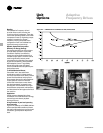
17
CTV-PRC007-EN
Condenser water temperature relief of
chilled water reset
Compressor lift reduction is required for
a chiller application, both to provide
stable chiller operation at part-loads and
to achieve greater energy savings.
Intelligent control to reduce condenser
water temperature, or chiller water reset
strategies are key to AFD savings in
chiller applications.
High kW Charges
Electric utility bills normally include both
demand and energy components. The
demand or kW portion is established by
usage during utility peak hours, by
individual peak usage or a combination.
This portion may or may not be
influenced by installation of an AFD. But
the energy or kWh portion will almost
certainly be reduced because of the
improved efficiency of the chiller plant
during part-load conditions throughout
the year. The greater the kWh charge, the
shorter the payback.
Operation
The Trane AFD controls the speed of the
chiller compressor by regulating the
output voltage in proportion to the
output frequency to provide a nominally
constant rate of voltage to frequency as
required by the characteristics of the
compressor motor. Motor speed is
proportional to this applied frequency.
The Trane AFD is a voltage source, pulse-
width modulated (PWM) design. It
consists of three basic power sections:
•
Converter — Semi-conductor bridge
rectifier takes incoming AC power and
converts it to a fixed voltage DC bus.
•
DC bus filter — The converted DC bus
voltage contains a significant amount
of ripple. The DC bus filter smooths the
voltage ripple from the converter with
capacitors and a DC link reactor to
supply a fixed constant voltage to the
inverter section. It also minimizes the
electrical harmonics generated by the
drive back to the distribution system.
•
Inverter — Converts the DC voltage
into a sinusoidal synthesized output
AC voltage. This synthesized output
controls both the voltage and
frequency which is applied to the
motor.
A fourth element of AFD design is the
microprocessor control logic which is
the intelligence for the power section. It
also includes all feedback sensors
required for stability in the system and
any required shutdown due to a fault.
Soft Start: Inrush Current and Torque
Trane AFD’s are programmed to start the
compressor motor from low frequency
and low voltage. The motor is brought
up to speed by increasing both
frequency and voltage at the same ratio.
Thus current and torque are much lower
during start-up and acceleration than the
high current, high torque associated with
across-the-line or even reduced voltage
starters.
Note that the actual torque developed by
the AFD is the total of the torque
required by the load and the accelerating
torque. The AFD is rated by output
current and is limited to a maximum of
100 percent continuous RLA through the
chiller control (UCP2). A 100 percent
output current capability results in 100
percent torque generated by the motor.
In other words, the drive regulates
output voltage in proportion to output
frequency to maintain ideal motor flux
and constant torque producing
capability.
Unit
Options
Adaptive
Frequency Drives


















